How to Win with ASO in the App Store: A Complete Guide to Grow Your iOS App in 2025 and Beyond
App Store optimization (ASO) is the cornerstone of success on Apple's App Store. It drives organic visibility and improves conversion rates, directly impacting the effectiveness of all your user acquisition efforts. As the App Store evolves, ASO strategies must evolve with it.
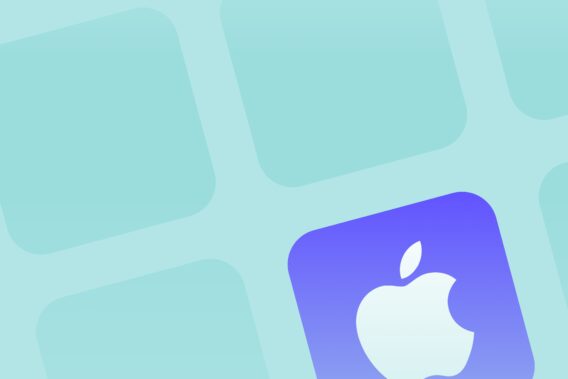
ASO for the App Store requires a unique approach. Apple’s algorithm works differently than Google Play’s, the product pages have distinct designs, and user behavior patterns vary significantly between platforms. What works on Android won’t necessarily work on iOS.
This comprehensive guide covers everything you need to know about iOS App Store optimization in 2025. It will show you the full scope of ASO for the App Store and how App Radar can elevate your app strategy, from research to implementation.
What is the full scope of ASO for the App Store in 2025?
App Store optimization focuses on two fundamental objectives: improving organic visibility in search results and increasing conversion rates from discovery to download. As Apple continues enhancing the App Store experience, ASO strategies must adapt to new ranking factors and user behavior patterns.
Improving organic visibility requires strategic optimization of your app’s discoverability signals:
- App metadata optimization (name, subtitle, keyword field)
- Keyword strategy and competitive positioning
- Category and subcategory selection
Converting users into downloads demands comprehensive app product page optimization (also known as store listing page):
- Visual assets (icon, screenshots, preview videos)
- App description and feature highlighting
- User ratings and review management
Proper ASO tactics in 2025 encompass broader app marketing integration:
- Discovery features: In-app events, App Clips, pre-orders
- Performance optimization: Regular updates, crash monitoring, load times
- Marketing alignment: Apple Ads integration, seasonal campaigns
- Privacy and accessibility: ATT optimization, privacy labels, inclusive design
- Competitive intelligence: Market monitoring, feature benchmarking
ASO requires understanding your app’s complete ecosystem – from technical performance to user experience to competitive landscape. Stong organic presence comes from coordinating these elements into a cohesive strategy rather than optimizing individual components in isolation.
Tip: ASO’s fundamental principles and best practices still apply to the App Store. Pay attention to localization and seasonality just like you would on Google Play. This article will guide you through activities and elements specific to the App Store.
How do you optimize for organic search results and visibility?
Organic visibility optimization requires understanding Apple’s current ranking algorithm and implementing strategies that align with confirmed ranking factors. Success depends on strategic keyword implementation, performance optimization, and staying current with algorithm updates.
Essential App Store ranking factors in 2025
The App Store algorithm evaluates multiple signals when determining search rankings, with keyword relevance serving as the foundation. Understanding the hierarchy of ranking factors enables more effective optimization strategies.
The most critical elements that influence the ranking process in the App Store include:
- App name: The most substantial weight of all ranking factors
- App subtitle: The second strongest ranking weight
- Keywords field: Significant impact, but not as much as the name and subtitle
- Developer name: Important but carries less weight
- In-app events: Keywords used in event names and short descriptions are also indexed
In our experience, performance and engagement signals are also important:
- Download velocity: Rate of downloads over specific time periods
- Total downloads and in-app purchases: Among the most vital ranking signals for both keyword and recommended app rankings
- User engagement quality: Clear indicators of genuine user satisfaction that Apple’s algorithm prioritizes
Recent algorithm updates emphasize authentic user engagement over manipulated metrics, reflecting Apple’s continued focus on providing users with relevant, high-quality app recommendations.
Tip: If you want to learn more advanced app marketing tips, we recommend reading our article on best practices for app store optimization.
How do you execute effective keyword optimization?
Keyword optimization remains critical for addressing ranking factors on the App Store. This strategic process involves proper research, selection, and implementation to identify the right keywords with genuine ranking potential.
The three-phase approach includes:
- Research: Finding keywords that are popular and logically relevant to your app
- Selection: Striking the right balance between relevance, popularity, and ranking difficulty
- Implementation: Strategically allocating keywords between the app’s name, subtitle, and keyword field for maximum ranking impact
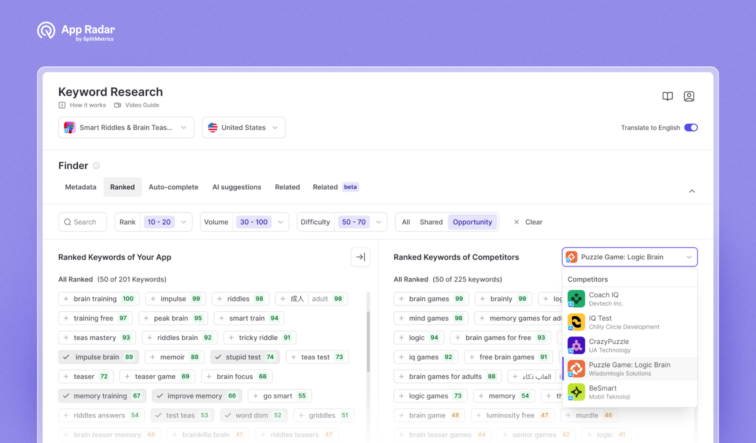
The most significant consideration for ASO specialists is making this process as data-driven as possible. While services like App Store Connect and Apple Ads provide valuable baseline insights, successful ranking requires granular, precise metrics for competitive analysis and opportunity identification.
How do you optimize conversion rates on the App Store?
Conversion rate optimization transforms app discovery into downloads by creating compelling product pages that resonate with your target audience. This process goes beyond technical specifications to focus on engaging visual and textual elements that drive user action.
The app conversion optimization begins before app launch through pre-release testing and continues throughout the app’s lifecycle to address user fatigue, seasonal trends, and evolving market expectations, thanks to services such as SplitMetrics Optimize, or Pre-Order campaigns.
What elements drive effective optimization of app's product page in App Store?
Optimizing your app’s product page involves strategically designing each visual and textual component to maximize user engagement and download intent. Achieving high conversion rates requires understanding how users interact with different elements across search results and full product pages.
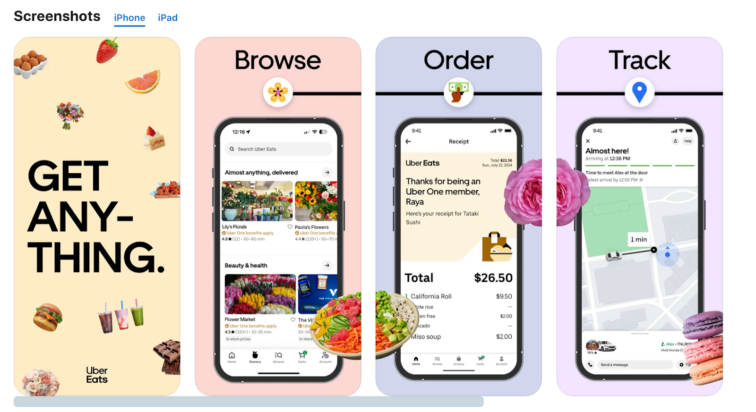
The core elements that impact conversion rates include:
- App icon optimization remains one of the most critical visual elements affecting both search result visibility and product page performance. The icon appears in search results, browse sections, and product pages, directly influencing tap-through rates and initial user impressions. Even minor icon adjustments can significantly impact both discovery and conversion metrics.
- App screenshots deliver the most substantial impact on App Store conversion rates, serving as the primary visual storytelling medium. Most apps acquire users primarily through search results, where screenshots provide the first detailed glimpse of the user experience. Creating a continuous visual narrative across screenshots helps users understand the app’s value proposition quickly and effectively.
- App preview videos provide comprehensive app demonstrations beyond static screenshots. However, not every app benefits from video content, and implementation should focus on quickly communicating core functionality and user benefits. Videos work particularly well for apps with complex interfaces or unique interaction patterns.
- App descriptions contribute to overall product page performance by providing detailed functionality explanations and keyword context. While having limited direct conversion impact compared to visual elements, descriptions support user decision-making and enhance the overall product page experience through comprehensive feature explanations.

How do you leverage Apple's advanced conversion features in App Store?
Apple’s Product Page Optimization testing enables A/B testing of screenshots, app previews, and app icons directly within App Store Connect. This built-in testing capability allows for data-driven optimization decisions based on actual user behavior rather than assumptions.
Custom Product Pages or CPPs allow creating targeted experiences for different user segments or marketing campaigns, enabling more precise conversion optimization for specific audiences or promotional activities.
Expert tip: Conversion strategies that succeed on Google Play don’t automatically transfer to the App Store due to different user behavior patterns, interface designs, and discovery mechanisms. Test and optimize specifically for iOS users and App Store browsing patterns.
What additional ASO tactics drive App Store success in 2025?
Additional ASO tactics have evolved alongside the App Store’s increasing sophistication, with Apple continuously introducing features that expand optimization opportunities. High-impact ASO requires leveraging these advanced capabilities to maximize both organic visibility and conversion performance.
The App Store’s commitment to enhancing user discovery experiences has created new ranking factors and promotional opportunities that ASO specialists can look into for competitive advantage. Each tactic contributes to organic performance through direct ranking influence or indirect engagement improvements.
Managing App Store ratings and reviews
Ratings and reviews in App Store fundamentally impact both conversion rates and editorial consideration for features and recommendations. Users consistently avoid apps with poor ratings, making review management a critical component of sustainable ASO strategy.
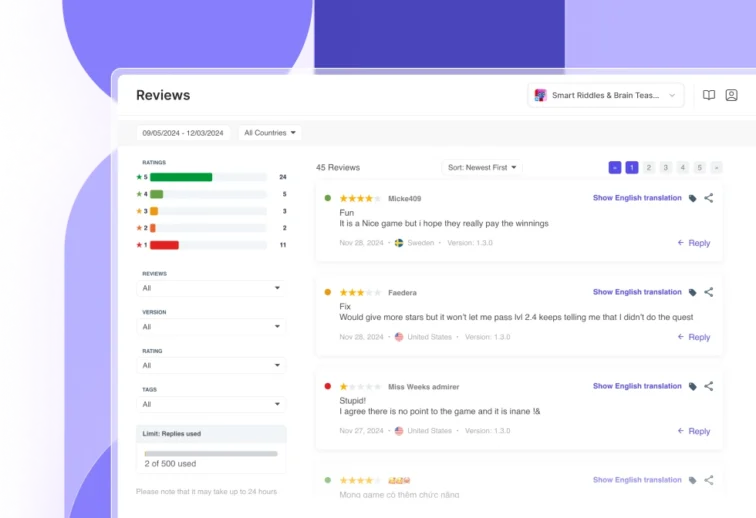
High-quality ratings begin with product excellence – your app must satisfy user expectations through bug-free functionality, smooth interactions, and clear value delivery. However, ASO specialists can actively influence review outcomes through strategic communication and feedback management.
App Radar’s AI-driven review management feature streamlines this process by generating ready-to-use replies and providing comprehensive review summaries, enabling efficient communication at scale while maintaining authentic user relationships.
Expert tip: You can reply to user reviews directly in App Store Connect, but leveraging automated tools significantly improves response efficiency and consistency across large review volumes.
How do in-app events boost organic performance?
In-app events in the App Store connect special promotions, offers, or content updates within your app to App Store discovery mechanisms. These events drive engagement, re-engagement, and new user acquisition while potentially influencing organic rankings.
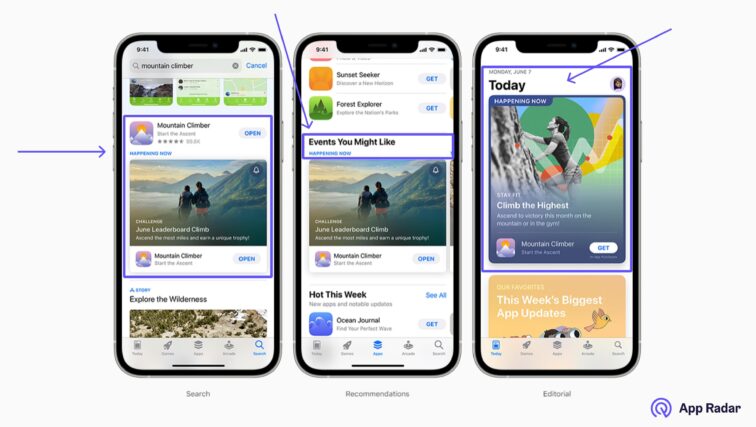
Apple displays in-app events across multiple discovery surfaces including search results, product pages, and the Today tab, creating additional visibility opportunities beyond traditional ASO elements. This expanded presence increases your app’s overall App Store footprint.
From an ASO perspective, properly optimized event metadata may influence keyword rankings, though Apple’s algorithm specifics remain undisclosed. The strategic approach assumes ranking benefits while focusing on confirmed conversion and engagement improvements.
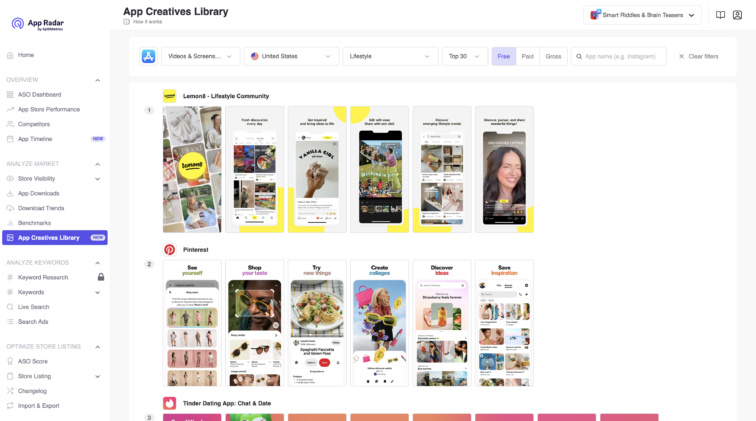
The indirect ranking benefits through improved conversion rates and download velocity make in-app events valuable for organic visibility growth, regardless of direct algorithm influence.
How do in-app purchases enhance ASO effectiveness?
In-app purchases (IAPs) can impact keyword optimization through metadata indexing, similar to in-app events. Strategic IAP optimization creates additional search exposure while driving revenue and user engagement.
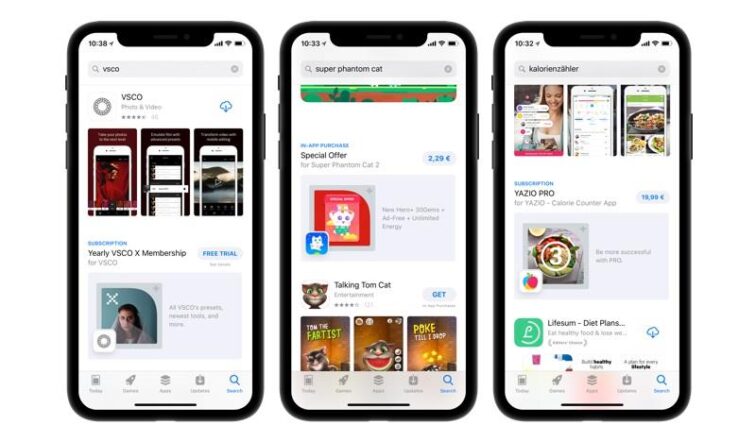
Promoted in-app purchases appear beneath your app store listing in search results, expanding your search presence and providing users with immediate purchase options. This enhanced visibility complements traditional organic ranking improvements.
How does App Store pre-order support ASO objectives?
App Store pre-order functionality allows establishing App Store presence before official launch, creating awareness and enabling strategic launch optimization. Pre-order campaigns can significantly impact initial ranking performance through coordinated user acquisition.
Pre-order apps appear in search results with specialized metadata display and “Order” buttons to provide early visibility and user commitment opportunities. Metadata and app builds remain adjustable throughout the pre-order phase, and so enabling optimization based on early user feedback.
Pre-order can also impact ASO by enabling a higher download velocity on launch, when an app may benefit from a newcomer’s amplified visibility. SplitMetrics’ case study of Livintis shows the impact of pre-order campaigns on organic rankings, with the help of Apple Ads.
How do you get your app featured in the App Store?
Getting featured in the App Store can be a huge boost to app’s organic visibility, delivering significant impressions, product page views, and installs from Apple’s most premium discovery surfaces. Unlike other ASO tactics, featuring requires exceptional app quality and strategic preparation, while simultaneously amplifying all other optimization efforts through increased visibility.
What types of App Store features should you target?
The App Store offers several editorial feature targeting opportunities with varying impact levels:
- Editorial stories appear in the “Today” tab and showcase apps following thematic narratives presented to users immediately upon opening the App Store. These features provide maximum exposure due to their prominent placement on the primary discovery surface.
- App or Game of the Day features highlight single applications through dedicated editorial stories with exclusive coverage and detailed app exploration. These features represent the highest individual app recognition possible on the App Store.
- Collections and daily lists present curated app groups organized by Apple’s editorial team around specific themes, use cases, or trending topics. While offering less individual spotlight, collections provide valuable category authority and discovery benefits.
The “Today” tab delivers the most significant visibility impact, reaching users regardless of their App Store visit intent. This opening screen receives more prominent placement than specialized “Games” or “Apps” tabs, making Today features exceptionally valuable for broad audience reach.
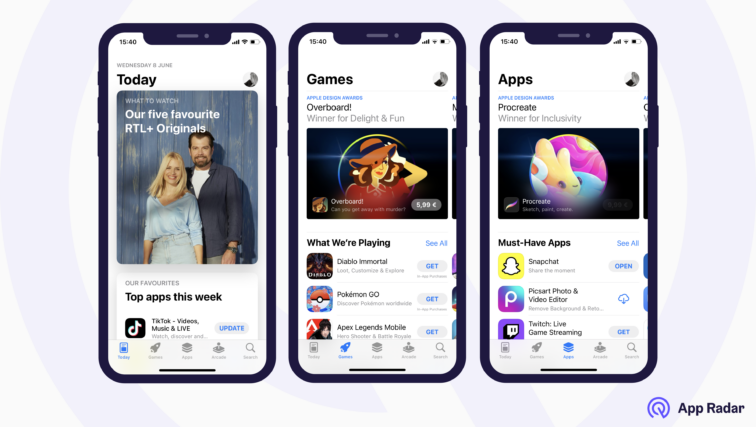
What criteria determine App Store featuring eligibility?
Apple editors evaluate apps based on multiple quality and innovation factors that extend beyond basic ASO optimization. Understanding these criteria enables strategic app development and positioning for editorial consideration.
For general apps, Apple prioritizes appealing and innovative features, uniqueness, overall quality, and exceptional user experience. Editorial teams seek apps that demonstrate clear value propositions and solve user problems in creative or efficient ways.
Games require additional considerations including engaging gameplay mechanics, compelling narratives, high-quality graphics, and optimal performance across devices. The gaming editorial process involves deeper evaluation of entertainment value and technical execution.
High app ratings serve as fundamental eligibility requirements, as quality represents Apple’s primary editorial concern. Apps must consistently deliver user satisfaction to warrant editorial team consideration.
How can you proactively work on getting featured in the App Store ?
Strategic featuring preparation involves optimization and storytelling that positions your app for editorial discovery and consideration. Successful featuring requires coordinating multiple elements before submitting to Apple’s editorial team.
Essential preparation steps include:
- Develop a compelling app story that clearly communicates your app’s unique value and user impact. Apple values narrative-driven content that resonates with diverse user audiences and demonstrates meaningful problem-solving.
- Time featuring requests strategically around major updates or significant app milestones to provide editors with fresh, newsworthy content that justifies featuring placement.
- Execute comprehensive App Store optimization including high-quality landscape screenshots, complete localization coverage, and polished metadata that meets Apple’s design and content standards.
- Prepare extensive visual asset libraries including promotional artwork, video content, and marketing materials that Apple can utilize if featuring invitations are extended.
- Submit detailed explanations of why your app excellently serves users through superior features, performance, and engagement metrics that differentiate your app from competitive alternatives.
- Before submitting your app’s story to Apple’s editorial team through the official featuring form, ensure comprehensive preparation across all optimization areas to maximize consideration probability.
Expert tip: App Radar can track app featurings of you and your competitors, send you alerts to prepare your assets on time, and monitor what kind of App Store featurings work for your competitors and their localizations.
How do you effectively manage ASO through App Store Connect?
App Store Connect serves as the central command center for all ASO activities, combining app management, performance analytics, and optimization tools in a unified platform.
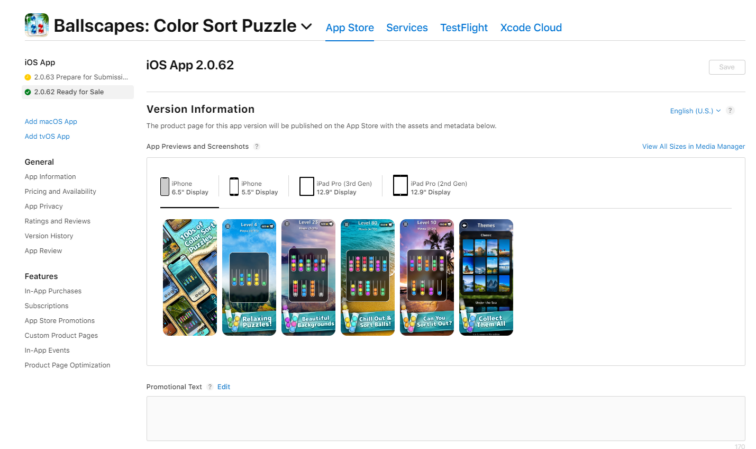
What are the essential App Store Connect features for ASO specialists?
ASO experts rely on specific App Store Connect sections that directly impact organic visibility and conversion performance.
The most critical sections for ASO management include:
- iOS app version information: Upload and manage store assets including preview videos, app screenshots, promotional text, descriptions, and keyword optimization across all localizations
- App information management: Configure app names and subtitles for multiple localizations, focusing on high-impact metadata fields that carry the most algorithmic weight
- Advanced App Store features: Leverage in-app purchases, in-app events, Custom Product Pages, and Product Page Optimization A/B testing to maximize organic performance potential
- Enhanced Analytics dashboard: Access comprehensive performance data including impressions, conversion rates, product page views, downloads, user engagement metrics, and the new cohort analytics for revenue attribution
- Sales and Trends reporting: Monitor subscription performance and financial metrics with the new Monthly Recurring Revenue (MRR) tracking capabilities introduced in 2025
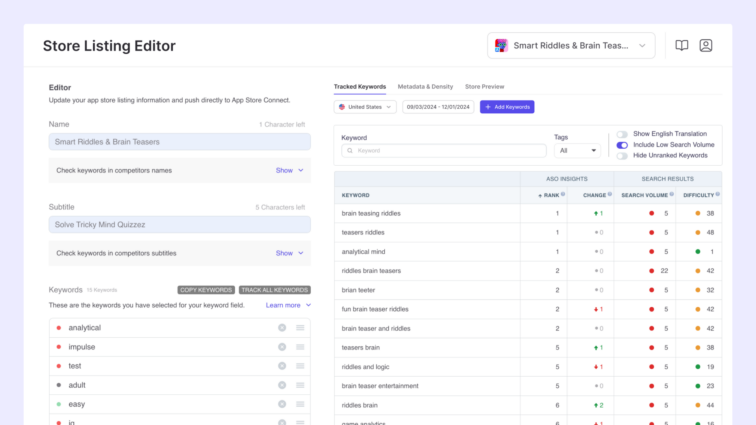
What new 2025 features enhance ASO management efficiency?
Apple’s 2025 App Store Connect updates have introduced several capabilities that streamline ASO workflows and provide deeper optimization insights.
Major 2025 enhancements include:
- API-driven automation: Upload builds programmatically through the App Store Connect API, enabling seamless CI/CD integration and automated metadata management
- Real-time webhook notifications: Receive instant alerts for build status changes, app review updates, and performance milestones without constant manual monitoring
- Apple-Hosted Background Assets: Manage up to 200GB of app content independently from app releases, enabling dynamic content strategies without app store review cycles
- AI-powered review summaries: Access automatically generated review insights that highlight key user feedback themes and sentiment trends
- App Store Tags integration: Monitor and customize AI-generated feature tags that improve app discoverability in search and browse results
- Enhanced Custom Product Pages: Assign specific keywords to custom pages and track their individual performance impact on different user segments
- Mobile TestFlight feedback: Review screenshots, crash logs, and user feedback directly from the App Store Connect mobile app for faster iteration cycles
App Radar integrates directly with App Store Connect to pull comprehensive data into a unified platform, eliminating the need to navigate multiple interfaces for ASO management. This integration enables efficient oversight of keyword performance, App Store analytics, and metadata optimization across all localizations.
How do you achieve synergy between ASO and Apple Search Ads?
Combining Apple Ads and ASO creates powerful growth by amplifying both organic visibility and paid campaign efficiency. Since both operate within the App Store ecosystem, they naturally complement each other for maximum impact.
Key synergy benefits
ASO improves Apple Ads performance by:
- Boosting conversion rates through optimized product pages
- Reducing cost-per-acquisition with better creative assets
- Aligning keyword strategies for maximum search visibility
Apple Ads enhances ASO effectiveness by:
- Delivering high-quality traffic that signals app quality to algorithms
- Providing keyword performance data for organic optimization
- Creating download velocity that can improve organic rankings
How do you implement effective coordination?
Strategic coordination focuses on three core areas:
- Keyword alignment: Use Apple Ads data to identify high-converting terms for organic optimization, while bidding strategically on keywords where you rank organically
- Creative optimization: Test visual assets through Apple Ads campaigns, then apply winning elements to your organic product page
- Performance integration: Monitor both channels together, adjusting bids when organic rankings improve and using paid traffic to maintain visibility for competitive keywords
The most effective approach treats ASO and Apple Ads as complementary channels rather than separate strategies, using insights from each to strengthen overall App Store performance.
What's the future of Apple App Store optimization?
App Store optimization is evolving from keyword-focused tactics to AI-driven, engagement-weighted strategies that prioritize user experience over raw download metrics.
How is AI transforming ASO practices?
Artificial intelligence now powers multiple aspects of ASO, from keyword research to creative optimization and performance prediction.
AI-driven optimization includes:
- Smart keyword discovery: AI tools analyze search patterns and competitor data to identify high-opportunity keywords automatically
- Dynamic creative testing: Machine learning algorithms optimize screenshots, icons, and descriptions based on real-time user behavior data
- Personalized product pages: Apple’s Custom Product Pages use AI to show different creative variants to specific user segments
- Review analysis automation: AI-generated review summaries highlight key user feedback themes, helping optimize based on sentiment trends
How should ASO strategy adapt for the future?
ASO will continue to go beyond traditional metadata optimization to encompass the entire user journey from discovery to engagement.
Future-focused strategies emphasize:
- Integrated analytics: Combining App Store Connect data with AI-powered insights for real-time optimization decisions
- Cross-platform coordination: Aligning ASO with broader app marketing efforts, including website and paid acquisition campaigns
- Dynamic personalization: Leveraging Custom Product Pages and AI targeting to deliver relevant experiences to different user segments
- Continuous testing: Using automated A/B testing tools to iterate on creative assets and messaging based on performance data
Success in future ASO depends on embracing AI tools while maintaining focus on genuine user value and engagement quality over vanity metrics.
TL;DR ASO for the App Store
Follow the advice listed throughout this article to create a checklist for optimizing your app’s metadata and making its product page as engaging as possible. In short:
- Understand all App Store organic ranking factors and that they are different from the ones for Google Play;
- Strategically research keywords and allocate them in product page metadata, understanding the function of each field: app name, subtitle, and the keyword field;
- Enrich your app’s product page with the best app icon, screenshots, and preview video of optimal length;
- Explore every opportunity the App Store offers: in-app events, in-app purchases, pre-order campaigns, editorials;
- Interact with your users through smart review management to drive engagement and better rankings in the long run;
- Synergize organic search results and ASO strategy with Apple Ads, the advertising channel native to the App Store;
For the most significant effect, you need to focus on every aspect of your user experience and funnel, and including paid user acquisition is equally important. Perhaps most importantly:
App Radar has all the data and insights you need to successfully address the tasks in this article. From comprehensive, AI-driven keyword research, granular and accurate organic metrics, to features aimed at making management of your iOS app as easy and efficient as possible.
Unlock AI-Driven ASO with App Radar
Start for FreeLatest Posts
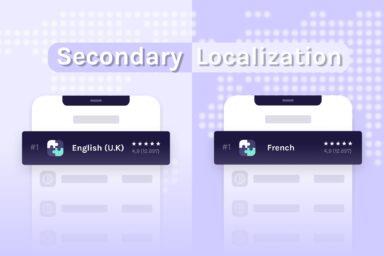
iOS App Product Page Localization: How to Use it the Right Way to Improve ASO
Top 10 Most Downloaded Games in Google Play Store (July 2025 Update)
Google Play Store Listing Experiments: How to Run Native A/B testing for Android Apps for Free!
12 Best Mobile Measurement Partners (MMPs) to Consider for Your Mobile App Attribution in 2025
Academy Lessons
Continue lessons

